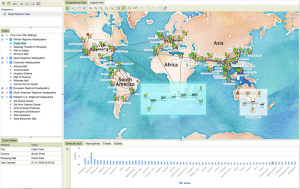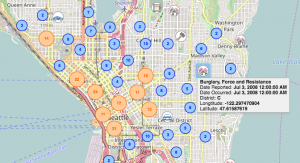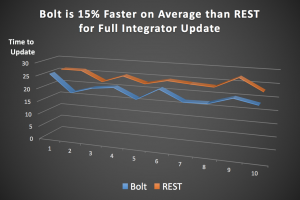We’re thrilled to announce that Tom Sawyer Perspectives, Version 7.6 for Java and .NET were made available last week. Version 7.6 introduces new Tom Sawyer Maps, support for the OpenLayers map API and the Neo4j Bolt protocol, and performance enhancements.
Tom Sawyer Maps
The intelligence community, network security managers, systems engineers, and architects share a common need—to see entities (people, places, things, and events) on geospatial maps. In addition they need to see logical drawings and schematics of the entities and relationships between them over time. Creating visualizations of all of this connected data on an ordinary geographic map is hard to do and the maps can get messy and extremely difficult to read.

Tom Sawyer Perspectives, Version 7.6
We took on the challenge of combining physical, logical, and functional views with the development of Tom Sawyer Maps in Tom Sawyer Perspectives, Version 7.6 and synchronizing multi-level nested views in a unified way in an easy to use visualization platform.
By now you can see why we’re so excited about Tom Sawyer Maps. It integrates the location-based information of a geographic map and the features and capabilities of a logical drawing view with advanced new features to create an all-inclusive, multi-level nested map view. This gives customers a unified view of their data in a single map.
Tom Sawyer Maps supports nesting, collapse and expand, drill-down and drill-up, labeling, data-driven markers, tooltips, and so much more.
If you would like to see our new maps, check out our Crime Network and Panama Papers demonstrations.

Since we’re always looking for ways to offer our customers more variety, this release provides support for the OpenLayers map API. The API can be used with map providers including OpenStreetMap, Apple Maps, and Google Maps. Not only is OpenLayers free open-source technology, it is also cross-browser compatible. Maps can now be adjusted to an even greater degree and can also be hosted privately and locally.
Neo4j Bolt Support
Graph databases have proven to be a great solution for connected data analysis. We are excited to introduce support for the Bolt protocol when connecting to a Neo4j graph database. Bolt is a new network protocol designed for high-performance access and is the fastest integration available today for retrieving data from Neo4j.

Tom Sawyer Perspectives, Version 7.6
While the Tom Sawyer Perspectives Neo4j integrator continues to support the REST protocol, we are delighted to offer users the option to use Bolt as well. We’ve tested Bolt on our own demonstrations and were pleased with the results. For example, when querying our Panama Papers data set, we saw a 15% response time improvement with Bolt. Besides the amazing speed, the encrypted security option for transferring data is a major boost in Version 7.6.
To summarize, the benefits of our Bolt support include:
- Speed: The binary Bolt protocol allows for lightning-fast access to your Neo4j graph databases.
- Performance: The Bolt connection-oriented protocol provides for higher throughput and lower latency.
- Security: Bolt provides an encrypted and even more secure option for transfer of data to and from Neo4j.
Performance and Customization Enhancements
Our layout system is now 9% faster and memory usage was also improved. Additionally, we now offer support for dynamic table column and inspector names which allows users the ability to customize the names to suit their needs.
Improved memory usage includes:
- 26% improvement in Circular layout
- 26% improvement in Hierarchical layout
- 18% improvement in Orthogonal layout
- 31% improvement in Symmetric layout
Don’t forget to tell us what you think of our new Tom Sawyer Maps by checking out one of our demonstrations and posting your feedback below. As always, we welcome your comments!
About the Author
Caroline Scharf, VP of Operations at Tom Sawyer Software, has more than 25 years leadership experience at large and small software companies. She has a passion for process and policy in streamlining operations, a solution-oriented approach to problem solving, and is a strong advocate of continuous evaluation and improvement.

Submit a Comment